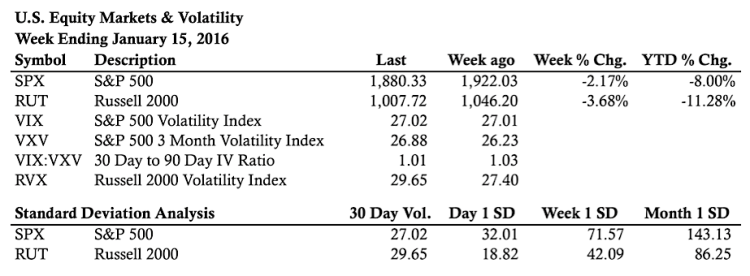Last weekend we took a look at a divergence in volatility. Specifically, I said that we haven’t seen the explosion in volatility that typically accompanies a stock market decline.
That volatility divergence continued this week and volatility still hasn’t reached panic levels. The VIX:VXV ratio actually declined and both VIX (30 day IV) and VXV (3 month IV) remained essentially unchanged. The relative complacency in volatility suggests that participants are largely hedged, steadily selling premium, or not that concerned about the stock market decline yet.
From a price standpoint, the S&P 500 hasn’t broken the 1850 level. While volatility has been under control through this stage of the stock market decline, breaking and holding below that level is likely to trigger a significant increase in volatility (both implied and realized). However, the price action towards the end of this week suggests that we might need to wait a bit longer for the panic decline to play out.
This week both the Russell 2000 and the S&P 500 slowed on the downside. At the same time, they began to display some signs of balance or consolidation. The range is pretty wide, but some of the price action we’re seeing is more constructive than what we saw the week before. If we do see the market pause or turn higher next week, it’s important to recognize that any move higher is likely to fail.
Intuitively, many market participants are still long or have been buying on the way down. One of the big signs that participants are still long is that we haven’t seen the capitulation that typically accompanies declines or an explosion in volatility. Volatility is under control and nobody has panicked yet. Additionally, we know that stocks tend to have an artificial buy side pressure. In other words, people are generally net buyers of stocks. While sellers have been aggressive over the past two weeks, heavy, panic selling hasn’t played a role in this stock market decline just yet.
If the market moves higher in the near future it’s likely to draw in some of the BTFDers while other participants use the opportunity to reduce their long exposure and/or get short. If enough participants begin to sell long positions, price could begin another leg of decline where it falls through the recent lows (1850ish on the SPX). More energetic selling and a significant increase in volatility are likely if the market breaks through on the downside.
Sure, the market could also stabilize and continue higher from this level, but technically broken markets don’t tend to stage major rallies until more damage than we’ve seen is done. Obviously we can’t predict where the market is going, but there are structural reasons for concern and rallies should not be trusted in this environment.
Have a good, longer weekend. The markets need the rest.
Market Stats:
Thanks for reading.
Twitter: @ThetaTrend
Author holds positions in Russell 2000 related securities at the time of publication. Any opinions expressed herein are solely those of the author, and do not in any way represent the views or opinions of any other person or entity.









